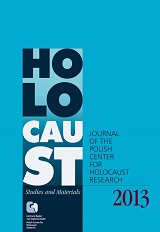Gone but not Forgotten: Archaeological approaches to the site of the former Treblinka Extermination Camp in Poland
Gone but not Forgotten: Archaeological approaches to the site of the former Treblinka Extermination Camp in Poland
Author(s): Caroline Sturdy CollsSubject(s): Archaeology
Published by: Stowarzyszenie Centrum Badań nad Zagładą Żydów & IFiS PAN
Keywords: Treblinka; Holocaust archaeology; extermination camp; physical evidence; Jewish Halacha law
Summary/Abstract: Public impression of the Holocaust is unquestionably centred on knowledge about, and the image of, Auschwitz-Birkenau – the gas chambers, the crematoria, the systematic and industrialized killing of victims. Conversely, knowledge of the former extermination camp at Treblinka, which stands in stark contrast in terms of the visible evidence that survives pertaining to it, is less embedded in general public consciousness. As this paper argues, the contrasting level of knowledge about Auschwitz-Birkenau and Treblinka is centred upon the belief that physical evidence of the camps only survives when it is visible and above-ground. The perception of Treblinka as having been “destroyed” by the Nazis, and the belief that the bodies of all of the victims were cremated without trace, has resulted in a lack of investigation aimed at answering questions about the extent and nature of the camp, and the locations of mass graves and cremation pits. This paper discusses the evidence that demonstrates that traces of the camp do survive. It outlines how archival research and non-invasive archaeological survey has been used to re-evaluate the physical evidence pertaining to Treblinka in a way that respects Jewish Halacha Law. As well as facilitating spatial and temporal analysis of the former extermination camp, this survey has also revealed information about the cultural memory associated with the site and how much has been forgotten about its history.
Journal: Holocaust Studies and Materials
- Issue Year: 2013
- Issue No: 3
- Page Range: 253-289
- Page Count: 37
- Language: English

